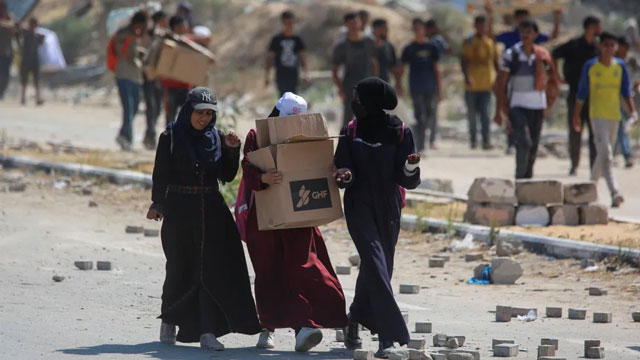Daijiworld Media Network - Gaza
Gaza, Nov 25: The controversial Gaza Humanitarian Foundation (GHF), backed by the US and Israel, has announced that it is shutting down its aid operations in the Palestinian territory after nearly six months of activity. This comes weeks after the organisation halted its three major food distribution centres following the ceasefire between Israel and Hamas.
The GHF was established with the aim of delivering aid independent of the United Nations, a move that immediately drew sharp opposition from UN agencies and international humanitarian organisations. They argued that the model was unsafe, unethical, and violated basic humanitarian principles. Chaos and violence repeatedly erupted near GHF distribution points, where hundreds of Palestinians were killed while trying to collect food—mostly due to Israeli fire, according to the UN. Israel, however, claimed its troops fired only warning shots.

In its announcement on Monday, the GHF described its mission as a “successful completion of its emergency operations”, stating that it had delivered over three million aid packages—equivalent to more than 187 million meals. Executive director Jon Acree added that the US-led Civil-Military Coordination Centre, a key element of President Donald Trump’s Gaza peace plan, would now adopt and expand the model the GHF had piloted.
The move drew praise from some US officials. State Department spokesperson Tommy Piggott claimed the GHF’s system—designed to prevent Hamas from accessing or diverting aid—played a pivotal role in pushing the group towards accepting the ceasefire. Hamas, however, denied stealing aid and welcomed the foundation’s closure. Spokesman Hazem Qassem accused the GHF of contributing to the suffering of Palestinians, calling for it to be held accountable for deaths, injuries, and what he described as the masking of a broader strategy of starvation implemented by Israel.
The GHF began its operations on 26 May, shortly after Israel eased an 11-week blockade that had created severe shortages in Gaza. Within months, famine was declared in Gaza City. The foundation’s food delivery points—run by US private security firms—were located inside Israeli military zones in southern and central Gaza, a setup widely condemned by aid groups. The UN said the model violated neutrality and endangered civilians by directing desperate families into militarised areas.
Between 26 May and 31 July, the UN’s human rights office documented at least 859 Palestinians killed in the vicinity of GHF sites, and another 514 deaths along the routes of UN and NGO convoys. Most casualties were attributed to Israeli forces. Israel disputed the figures, while the GHF denied that any shootings occurred at its own sites, accusing the UN of relying on data from Gaza’s health ministry.
With the ceasefire now in place, the foundation’s future had already appeared uncertain. The peace plan’s initial phase specifies that future aid should be managed through neutral agencies such as the UN and the Red Crescent, excluding organisations linked to either Hamas or Israel.
Reacting to the shutdown, UN spokesperson Stephane Dujarric said it would have no effect on UN operations, adding that the organisation had never worked with the GHF. He noted that although more aid has entered Gaza since the ceasefire, it remains insufficient for the 2.1 million residents who continue to face critical shortages across the territory.